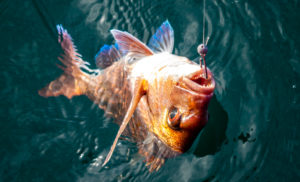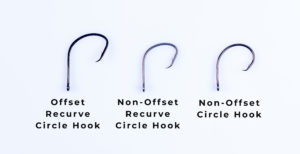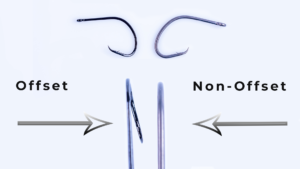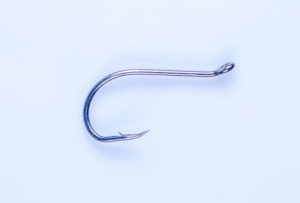
Fisher’s often have a favourite hook they like to fish with. The number one reason for their choice – they percieve that hook catches them more fish or perhaps bigger fish than other types of hook. Hooks are of course designed to catch fish. Some hooks however are better at doing less harm to the fish should the fish need to be returned to the water. This is important to consider when thinking about what is best for the long term health of our fishery. It may take a small change in our approach to how we fish a different style of hook to really do our fishery (and ourselves) a favour. Harm and subsequent mortality occurs when fish are hooked in the throat, gills or gut. Lip hooked fish have a much better chance of survival if handled carefully and quickly released after capture.
Hook Styles
Circle Hooks.
Cicrle hooks are fairly self explanatory as they are fashioned in the shape of a circle (more so than other styles). Circle hooks maybe either ‘offset’ or ‘non-offset’. The purpose behind the design of the circle hook is so that the hook slides into the corner of the mouth, lip hooking the fish and so avoiding hooking the fish in the gut. There are different styles of circle hook, i.e. circle, recurve and kahle hooks.


There have been studies done on the safety and efficacy of both styles of circle hook (predominantly in the game fish fishery). The data shows that non-offset circle hooks are most effective at lip hooking fish than offset hooks. Offset circle hooks are still safer than the suicide or octopus style of hooks and some varieties of offset circle hooks can be straightened into a non-offset shape with a vice or pair of strong pliers. Circle hooks are used predominantly when fishing with bait – either bait that hs been cut up or when using a live or dead whole fish. In some South American fisheries where game fishing tourism is a major source of income, it is illegal to use anything except circle hooks when fishing baits. This measure has been taken to ensure fish released have their best chances of survival.
When fishing with circle hooks, fishers have to be aware that the strike is different when setting the hook. Many fishers enjoy yanking the rod high to set a hook into a biting fish. Unfortunately, this action will usually fail to hook a biting or nibbling fish as the hook must be steadily or gently slid into the corner of the mouth as the fish turns with the bait in its mouth. It may take some adjusting however the rewards are worth it. Fish will often hook themselves if the fisher simply slowly winds or gently lifts the rod when a fish grabs the bait.

Circle hooks don’t have a set sizing scale like other styles and so the size attributed may be different between brands of hook. There may not be a large difference in size between brands but it is worth noting if you change from one manufacturer to another. Your choice of hook size will also change depending on the species you are targeting and even the aggression of the fish when you are fishing. Smaller mouthed species like tarakihi require 4/0 or larger hooks, snapper 5/0 or larger and blue cod 6/0 or larger hooks. If in practice you are gut hooking fish because they are hungrily taking down your whole bait (or you happen to encounter larger than usual specimens) then change up in size so that any unwanted fish can be safely released.
Suicide or Octopus Hooks
These are one of the most common forms of hook used by bait fishers. They are predominantly in the offset style and they also gut hook fish more often than circle style hooks. Fishers typically set the hook with a fast sharp jerk on the rod when they feel a bite. Rods left in the rod holder usually mean even small fish can eventually swallow large hooks if given enough time. If you want to fish with this style of hook, we recommend using large sizes, 7/0 or larger to reduce the risk of gut hooking fish. Don’t let the fish run with the bait as this means they are more likely to swallow the hook.
Target Appendage Hooks
Target appendage hooks are simply hooks that have a single wire arm that is attached to the hook via a snell knot and stands proud from the back of the shank. This prevents undersized fish from swallowing the hook but still allows legal-sized snapper to get caught. Smaller recurve or circle hooks can be used in conjunction with these devices, with little chance of fish swallowing the hook and bait. A trial was conducted involving 13,000 hooks with octopus and circle hooks, in two different seasons (January and June) with three different types of bait. The slightly longer appendage hooks on circle hooks returned the best results, with only a very few 2% of fish caught being deep hooked. They also caught the lowest number of undersized fish as well.

Target appendage hooks are good for long line and rod fishing. The hooks come in pre-tied packs or you can tie your own using the specially made appendages, hooks (preferably circle hooks) and a snell knot.
Snell knots will lap over the wire and help the appendage sit up straight to work effectively. They can be sourced online from Paul’s Kite fishing shop.
Removing the barbs on all hooks
We recommend removing the barbs on hooks so that fish can be easily released. This can be done by filing the barb off or flattening it down with a pair of pliers. Babrless hooks are starting to be sold commercially in Japan and will no doubt start to make their way into our part of the world in due course. There is little or no difference in the retention rate of using barbless hooks, as long as fishers maintain pressure while playing their fish. Barbless hooks are also beneficial for removing from fisher’s hands when accidentally hooked.



